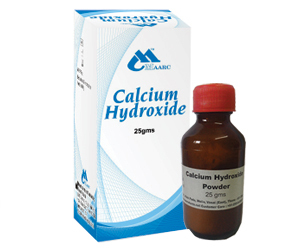 Calcium hydroxide( calcium hydroxide, calcium hydroxide) is used not only in the production and cosmetology, but also in dental medicine.
Calcium hydroxide( calcium hydroxide, calcium hydroxide) is used not only in the production and cosmetology, but also in dental medicine.
Calcium hydroxide is used in dentistry mainly for processing, temporary and permanent filling of root canals.
Calcium hydroxide does not have significant side effects, however, its use must comply with certain rules.
Contents
- Substance characteristics
- Essential for endodontics pharmacological properties of
- Mechanism of action
- Reasons and uses of
- Popular materials based on calcium hydroxide
- Application for temporary filling
- Prejudice of dentists
Characteristic of substance
Calcium hydroxide is an inorganic compound that is produced inform of powder. The pharmaceutical industry produces dental materials based on calcium hydroxide of various types. Their main difference in the amount of content of a chemical compound in the composition. One of the most effective is pure calcium powder.
Among the many diverse chemicals that are used in dental medicine, materials based on
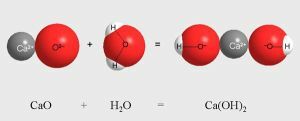
hydroxide The formula and structure of the calcium hydroxide molecule
calcium is most often used. This is due to the unique properties of the substance.
Calcium hydroxide has an alkaline reaction to the tissue, which destroys the pathogens that cause the destruction of the tissues of the dental canals.
In most cases, such materials are used for temporary filling of channels, with the purpose of destruction of organic tissues under the influence of alkaline medium.
The result is noted 10-14 days after the installation of the temporary seal. During this time, the reaction between the inorganic powder dissolved in saline solution and the root tissue allows not only to destroy the pathogenic bacteria, but also to decontaminate all areas that are not accessible for mechanical cleaning.
Pharmacological properties of
important for endodontics The main pharmacological properties of calcium hydroxide are antibacterial effects. Dental diseases associated with the lesion of the intracanal area of the tooth often develop as a result of the multiplication of bacteria.
Most microorganisms of this type can not exist in an alkaline environment. Under the action of an alkaline reaction of the calcium solution, some types of bacteria die right away, to destroy others, it takes more time.
Calcium hydroxide reacts with saline solution, thanks to this reaction and the antiseptic effect of the powder appears. After dilution of the substance in the aqueous liquid, a release reaction of the hydroxyl ions takes place, which have an antibacterial effect, due to the destruction of the membrane and DNA of the microorganisms.
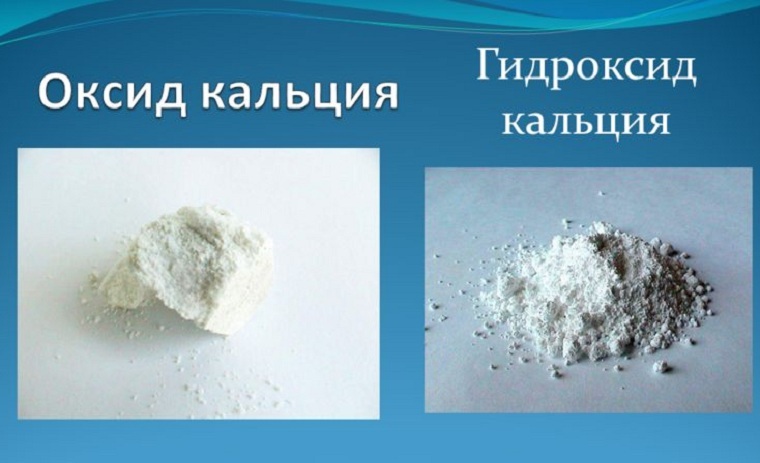
Mechanism of action
As a result of the application of dissolved powder to the root canals, a reaction begins between the substance, the tissue cells and the microflora of the inside of the tooth. Hydroxide diffuses through the channels of dentine and penetrates deep into the pulp.
The mechanism of action of calcium hydroxide is designed to provide antimicrobial, anesthetic and therapeutic effect. Due to the prolonged presence of the drug in the cavity of the tooth, the treated area is completely disinfected and loses its sensitivity, which allows to carry out further treatment and establish seals or medical pads without any risks.
Basis and purposes of application
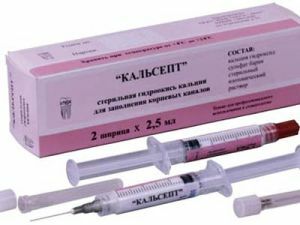 The scope of the substance in dentistry is rather narrow. Direct application of calcium hydroxide in endodontics is the treatment and filling of root canals. The basis for use is the diagnosis of pathological processes in the area of pulp and hard tooth tissues.
The scope of the substance in dentistry is rather narrow. Direct application of calcium hydroxide in endodontics is the treatment and filling of root canals. The basis for use is the diagnosis of pathological processes in the area of pulp and hard tooth tissues.
When the material is in the channel cavity for more than two weeks, the powder is cemented, which leads to a complete hermetic sealing of the channel. In certain cases, this effect is used by dentists purposefully, if other methods of treatment are unacceptable.
It should be clarified that preparations with calcium hydroxide can be used in the surgical treatment of injuries of the jawbone composition, as well as with bone plastic.
Calcium hydroxide is also used in the dental field for internal therapeutic effects. Materials with a calcium base are used if the following diseases are diagnosed:
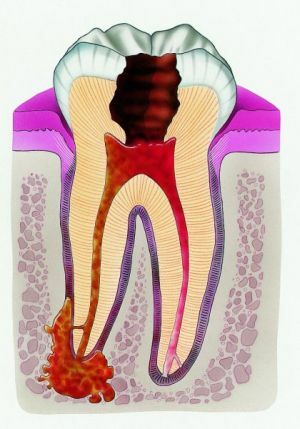
Calcium hydroxylation treatment is topical for periodontitis
- pulpitis;
- inflammation in the bone tissue;
- neoplasm( granuloma, cyst);
- periodontitis;
- periodontitis;
- deep caries.
Calcium hydroxide can also be used after a surgical procedure to remove neoplasms or nerves. Used to fill channels before installing permanent seals, or implants.
Unlike many other medications used in dentistry, calcium hydroxide does not have a side effect and can be contraindicated, solely, with the intolerance of the chemical itself.
Popular materials based on calcium hydroxide
In dentistry, in addition to pure calcium hydroxide powder, materials based on it are used. Their difference lies in the complex composition, the lower dosage of the main component, and also in the form of release.
The most popular and popular are:
- Calcicur( aqueous suspension);
- Calcadent( powder for suspension);
- Contrasil( lacquer);
- Calcimol( calcium salicylate cement);
- Ultra-Blend( polymer material).
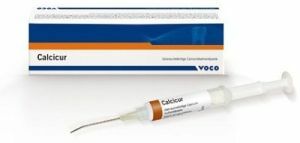 Each preparation has its own characteristics, therefore, depending on the indications and purposes of use, a specialist can carry out the procedures with the help of one or another remedy.
Each preparation has its own characteristics, therefore, depending on the indications and purposes of use, a specialist can carry out the procedures with the help of one or another remedy.
Dental preparations with calcium hydroxide refuse to stimulate the formation of the substitute dental substance, prevent the penetration of pathological microorganisms into the pulp and have an anti-inflammatory effect.
Features of materials and their applications:
- Calcicur and Calcadent - aqueous suspensions based on calcium powder. The chemical is about 40% of the total composition, the remaining 60% - water, or saline. The paste does not harden. A means is used to decontaminate the cavity to be treated.
- Contrasil is a quick-drying lacquer with 40% hydroxide and 60% impurities in the form of zinc oxide, solvent( highly volatile), resin and chloroform. The preparation treats the area of dental tissue, which is prone to carious lesions. Apply lacquer for temporary protection of tissues from the acid medium when using dental cements.
- Calcimol is a substance of the calcium-salicylate group that solidifies under chemical attack. The drug is applied in the form of a gasket before installing a permanent seal. The composition includes 50% hydroxide, 40% salicylic ether and 20% impurities( dyes and plasticizers).The gasket made of Kalkimol does not have high strength, but does not affect the polymerization and color of the fixed permanent seal.
- Ultra-Blend belongs to the group of polymer materials that are cured by exposure to light. Ultra-Blend contains 40% calcium hydroxide powder, 30% contrast X-ray filler and 30% polymer resin( hardener).The substance has a high mechanical strength, but is only used to install the gasket for shallow damages. In addition, the material has a weak therapeutic effect.
Application for temporary filling
The main area of application of preparations based on hydroxide and pure calcium hydroxide powder is the procedure for tooth filling. Materials with a chemical substance are used in the form of temporary and permanent seals.
As preparations change microflora in the field of their application, and as can harden, their application should be carried out under the certain scheme.
The technician in the process of setting the temporary seal should perform the following actions: 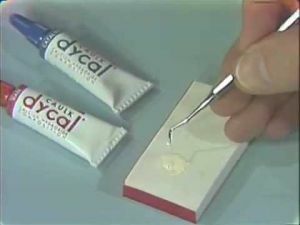
- measure the length of the processed channel;
- to mix calcium powder with saline solution( use ready-made drug);
- dipped the required channel material in the material;
- insert the tool into the channel, not reaching its end 1 mm;
- run the rotation of the channel filler to process the desired areas.
Only after the process is repeated three to four times, the dentist can seal the tooth with a small layer of cement.
To improve the effectiveness of treatment should follow the following rules:
- root canal should be maximized;
- after dilution, the finished material should have a creamy consistency;
- channels must first be cleaned and processed;
- the time of the material in the tooth cavity is at least 2, but not more than 4 weeks.
How to properly mix cement based on calcium hydroxide:
Bias of dentists
Despite the fact that calcium hydroxide has been used in dental medicine for more than half a century, dentists still do not have a common opinion about the peculiarities of its use.
The official instruction to any preparation warns that all materials with hydroxide should be in the dental canal no longer than one month, however, some specialists practice the installation of hydrocalcium fillings for six months or more. This practice is not widely used, therefore, in dental practice, doctors prefer to follow the rules of the official instruction.
Studying the statistics regarding the effects of Ca( OH) 2 powder, dentists raised the issue of the effect of the substance on a number of microorganisms that do not lend themselves to the antibacterial potential of the substance and subsequently cause exacerbations and relapses.
In this regard, some experts prefer to replace the installation of temporary gaskets in the form of a layer of calcium hydroxide for the complete cleaning of the cavity of the tooth with sodium hypochlorite and the installation of temporary seals made from modern preparations that carry out a complete hermetic sealing.
However, despite the development of dental medicine, calcium hydroxide continues to be widely used in dentistry, and specialists are discovering more directions for its application.
